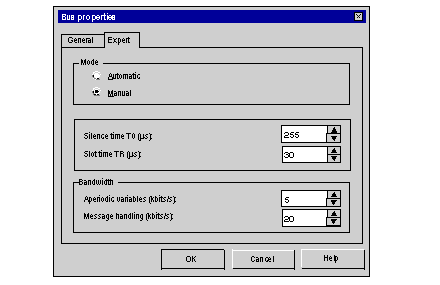|
Expert Tab: Manual Mode
|
|
|
(Original Document)
|

|
Reference
|
Description
|
|---|---|
|
Silence time delay T0
|
This defines the maximum time between the transmission of the last byte of a frame and the transmission of the first byte of the following frame.
This time is expressed in micro-seconds.
Its value must be greater than the reversal time TR and less than 255.
|
|
Reversal time TR
|
This defines the minimum time between the transmission of the last byte of a frame and the transmission of the first byte of the following frame.
This time is expressed in micro-seconds.
Its value must be greater than or equal to 1 and less than the silence time T0.
|
|
Reference
|
Description
|
|---|---|
|
Aperiodic variables
|
This defines the output of the aperiodic variables which can circulate on the bus.
This bandwidth is expressed in Kbits/s.
Its value can be adjusted from 1 to 200 Kbits/s.
|
|
Messaging
|
This defines the output of the aperiodic messages which can circulate on the bus.
This bandwidth is expressed in Kbits/s.
Its value can be adjusted from 1 to 200 Kbits/s.
|